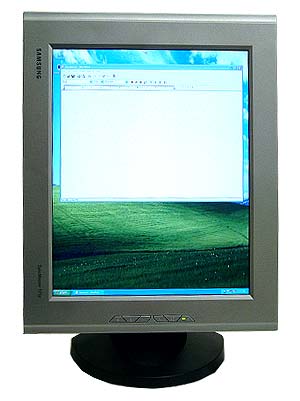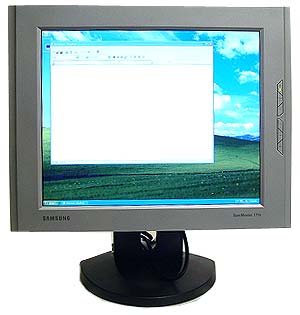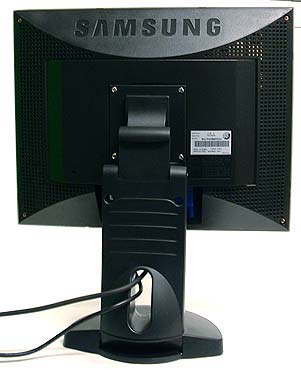|

|
 |

|
|
With these three pictures we are showing you three things. The first
image shows you the 171B when it has been oriented in the Portrait
position. Note how the controls are now nicely at the bottom of the LCD,
instead of up on the left hand edge.
The second image just shows the unit in its normal landscape
orientation with the base at the lowest level. The control panel is up on
the right and side of the bezel and easily reachable, without being
distracting to the eye in any way.
Finally, the last image shows you the rear of the display, and
illustrates the adjustable stand. The 171B in that picture is raised as
high as the stand will allow for, which is roughly 55mm of
travel.
|
 A Display that Tilts 90
Degrees:
A Display that Tilts 90
Degrees:
Tilting displays are not entirely new to
Samsung, but this is the first one we have seen in a while. The stand that
the 171B uses has a built-in pivot which enables the display to rotate from the
standard portrait position to a vertical landscape orientation. To do this one
need only raise the monitor to the tallest height or tilt the display back
slightly so the corners will clear the base stand.
The actual display image is pivoted with the
help of some bundled software called Pivot Pro 6.01. To rotate the screen image,
the user need only right click on the desktop and select "rotate 90" from the
menu which pops up.
The software was buggy under our test
system which was running WindowsXP, and would cause the system to reboot itself every time we
clicked the start button with the screen in portrait mode.
Also of note, is that that the OSD menus are not affected by the
software, so when you rotate the screen they remain in their original
orientation.
The adjustable stand bolts on to the back of the actual display
panel by the 100mm VESA mounting points and can be removed if wall mounting is more
desireable.
The adjustable base is really welcomed, but when
you are lowering the screen to the bottom the display 'thumps' into place,
instead of making a nice smooth transition. From the down position, the display
can be raised up 55mm.
Even though the power supply is contained within the panel unit,
the display still manages to remain pretty slim at just about 65mm thick. A plug like the
kind you see now a days for notebooks plugs directly into the panel display to provide
power.
Apart from that the only other cable you can hook
up to the unit is an analog VGA adaptor. Both cables can be threaded through the
base to keep them under control and out of the way when rotating the
display.
On this
particular rotating stand, the 171B will tilt about 3 degrees forward and 15 degrees back to accommodate
different user positions. The display moves smoothly, and can be tilted with just one hand if
necessary.
There is a lazy-susan in the base of the stand, but
we found it a bit stiff to use and wonder how effective it is over just rotating
the entire unit.
